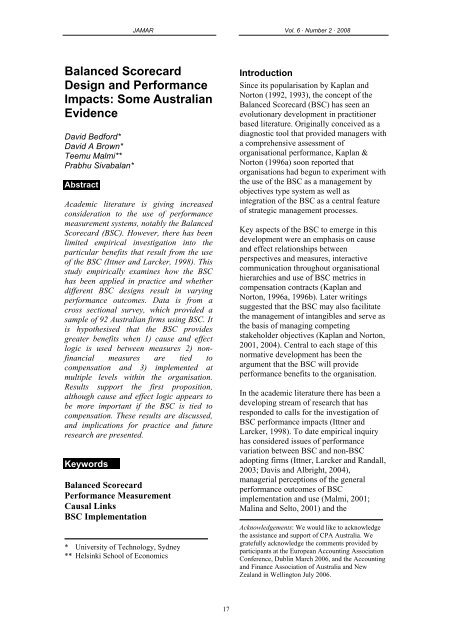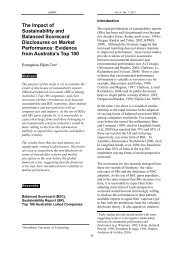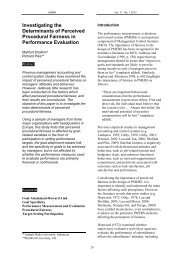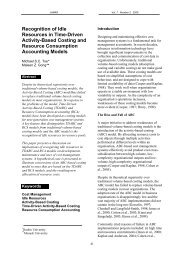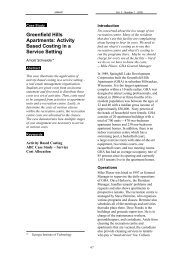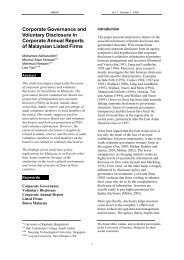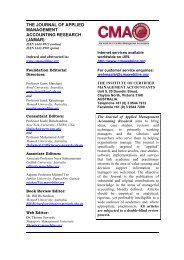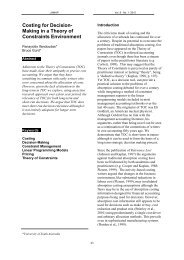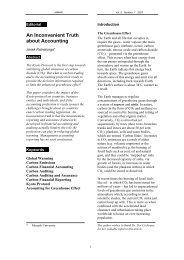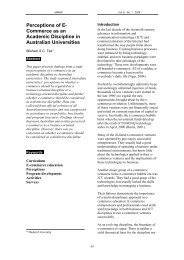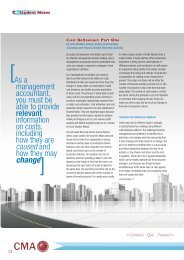Balanced Scorecard Design and Performance Impacts: Some ...
Balanced Scorecard Design and Performance Impacts: Some ...
Balanced Scorecard Design and Performance Impacts: Some ...
You also want an ePaper? Increase the reach of your titles
YUMPU automatically turns print PDFs into web optimized ePapers that Google loves.
JAMAR Vol. 6 · Number 2 · 2008<strong>Balanced</strong> <strong>Scorecard</strong><strong>Design</strong> <strong>and</strong> <strong>Performance</strong><strong>Impacts</strong>: <strong>Some</strong> AustralianEvidenceDavid Bedford*David A Brown*Teemu Malmi**Prabhu Sivabalan*AbstractAcademic literature is giving increasedconsideration to the use of performancemeasurement systems, notably the <strong>Balanced</strong><strong>Scorecard</strong> (BSC). However, there has beenlimited empirical investigation into theparticular benefits that result from the useof the BSC (Ittner <strong>and</strong> Larcker, 1998). Thisstudy empirically examines how the BSChas been applied in practice <strong>and</strong> whetherdifferent BSC designs result in varyingperformance outcomes. Data is from across sectional survey, which provided asample of 92 Australian firms using BSC. Itis hypothesised that the BSC providesgreater benefits when 1) cause <strong>and</strong> effectlogic is used between measures 2) nonfinancialmeasures are tied tocompensation <strong>and</strong> 3) implemented atmultiple levels within the organisation.Results support the first proposition,although cause <strong>and</strong> effect logic appears tobe more important if the BSC is tied tocompensation. These results are discussed,<strong>and</strong> implications for practice <strong>and</strong> futureresearch are presented.Keywords<strong>Balanced</strong> <strong>Scorecard</strong><strong>Performance</strong> MeasurementCausal LinksBSC Implementation* University of Technology, Sydney** Helsinki School of EconomicsIntroductionSince its popularisation by Kaplan <strong>and</strong>Norton (1992, 1993), the concept of the<strong>Balanced</strong> <strong>Scorecard</strong> (BSC) has seen anevolutionary development in practitionerbased literature. Originally conceived as adiagnostic tool that provided managers witha comprehensive assessment oforganisational performance, Kaplan &Norton (1996a) soon reported thatorganisations had begun to experiment withthe use of the BSC as a management byobjectives type system as well asintegration of the BSC as a central featureof strategic management processes.Key aspects of the BSC to emerge in thisdevelopment were an emphasis on cause<strong>and</strong> effect relationships betweenperspectives <strong>and</strong> measures, interactivecommunication throughout organisationalhierarchies <strong>and</strong> use of BSC metrics incompensation contracts (Kaplan <strong>and</strong>Norton, 1996a, 1996b). Later writingssuggested that the BSC may also facilitatethe management of intangibles <strong>and</strong> serve asthe basis of managing competingstakeholder objectives (Kaplan <strong>and</strong> Norton,2001, 2004). Central to each stage of thisnormative development has been theargument that the BSC will provideperformance benefits to the organisation.In the academic literature there has been adeveloping stream of research that hasresponded to calls for the investigation ofBSC performance impacts (Ittner <strong>and</strong>Larcker, 1998). To date empirical inquiryhas considered issues of performancevariation between BSC <strong>and</strong> non-BSCadopting firms (Ittner, Larcker <strong>and</strong> R<strong>and</strong>all,2003; Davis <strong>and</strong> Albright, 2004),managerial perceptions of the generalperformance outcomes of BSCimplementation <strong>and</strong> use (Malmi, 2001;Malina <strong>and</strong> Selto, 2001) <strong>and</strong> theAcknowledgements: We would like to acknowledgethe assistance <strong>and</strong> support of CPA Australia. Wegratefully acknowledge the comments provided byparticipants at the European Accounting AssociationConference, Dublin March 2006, <strong>and</strong> the Accounting<strong>and</strong> Finance Association of Australia <strong>and</strong> NewZeal<strong>and</strong> in Wellington July 2006.17
JAMAR Vol. 6 · Number 2 · 2008association between non-financialperformance measures <strong>and</strong> financialoutcomes (Said, et.al, 2003; Bryant, Jones<strong>and</strong> Widener, 2004). These initialinvestigations, however, have provided lessthan definitive findings as to the particularperformance benefits that may result fromBSC application.While most of these studies have beenconfined to small samples or single firmcase studies, or have used external datasources that may not appropriately proxyfor BSC design <strong>and</strong> use, a morefundamental issue exists in the study ofBSC performance impacts. In view of theevolutionary development of the BSC,organisations can develop scorecards thathave a range of different technical designs<strong>and</strong> styles of use. Two descriptive studieshave considered this issue thus far (Malmi,2001; Speckbacher, Bischof <strong>and</strong> Pfeiffer,2003).These studies suggest that common to allBSCs is the inclusion of both financial <strong>and</strong>non-financial indicators grouped around anumber of key organisational perspectives,but that beyond this baseline BSC a rangeof design choices exists. These include theextent to which cause <strong>and</strong> effect logic isbuilt into the BSC design, the extent towhich compensation is tied to non-financialmeasures, <strong>and</strong> the extent to which it hasbeen implemented on multiple levels of theorganisational hierarchy (Kaplan <strong>and</strong>Norton 1996a, 1996b, 2001, 2004; Malmi,2001; Speckbacher, et.al, 2003). Giventhese alternatives in design, performanceoutcomes are likely to vary contingent uponthe stage of development adopted, howeverthere is little evidence of this (Chenhall,2005).This paper considers whether different BSCdesign choices, reflected in normative <strong>and</strong>academic literature, impact upon the typesof benefits <strong>and</strong> overall outcomes derived byorganisations. This is an important researchquestion for a number of reasons. First,BSC adoption rates have beencomparatively high relative to othermanagement innovations (Speckbacher,et.al, 2003). With many organisationsinvesting in the BSC, its usefulness <strong>and</strong>impacts on performance is a particularlysalient issue (Atkinson, et.al, 1997; Ittner &Larcker, 1998; Chenhall, 2005).Second, criticisms of the BSC (Norreklit2000, 2003) <strong>and</strong> uncertainty surroundingthe extent to which firms achieve realbenefits from implementation <strong>and</strong> use(Malmi 2001; Malina <strong>and</strong> Selto 2001; Ittner<strong>and</strong> Larcker, 2003) may be at least partiallyattributable to sub-optimal design <strong>and</strong>application in practice (Kaplan <strong>and</strong> Norton,1996b; Ittner <strong>and</strong> Larcker, 2005).Third, as the BSC is largely a practicederived innovation, theoretical argumentsexplaining how <strong>and</strong> why particularoutcomes are realised are still at thedevelopmental stage in academic literature.Empirical examination of these issues willcontribute to the emerging stream ofliterature considering the design <strong>and</strong> use ofcontemporary performance measurementsystems <strong>and</strong> add to the development of amore grounded theoretical frameworkexplaining how these systems act to driveorganisational outcomes (Malmi, 2001;Malina <strong>and</strong> Selto, 2001; Ittner, et.al, 2003;Speckbacher, et.al, 2003; Davis <strong>and</strong>Albright, 2004; Tuomela, 2005; Chenhall,2005).To examine this research question, datafrom a cross sectional survey of 92Australian organisations were considered.The first part of the data analysis testspropositions relating to three keycharacteristics of BSC design <strong>and</strong> use <strong>and</strong>their impacts on benefits. Results show thatthe use of cause <strong>and</strong> effect logic betweenmeasures was associated with the 11 BSCrelated benefits identified <strong>and</strong> with two ofthe three overall success outcomes. Thetying of compensation to non-financialmeasures of BSC was associated with onlyfour of the 11 benefits <strong>and</strong> did not impactany of the overall success outcomes.Finally, the extent to which the BSC hadbeen implemented throughout theorganisational hierarchy had no significantimpact on benefits or success outcomes.Further sensitivity tests were thenundertaken to underst<strong>and</strong> how the18
JAMAR Vol. 6 · Number 2 · 2008combination of cause <strong>and</strong> effect along withcompensation impacted upon BSC benefits.The analysis found that when compensationwas linked to non-financial indicators,greater benefits were achieved when cause<strong>and</strong> effect was also included as a BSCcharacteristic, suggesting that an interactioneffect exists between these design choices.The paper is organised into the followingfour sections. The first section reviews therelevant BSC literature <strong>and</strong> outlinespropositions concerning the three keydesign characteristics <strong>and</strong> associatedorganisational benefits <strong>and</strong> outcomes. Thesecond section considers the researchmethod <strong>and</strong> design. The third sectionpresents the findings from propositiontesting <strong>and</strong> further sensitivity analyses withthe final section providing a discussion ofthese results <strong>and</strong> their implications forresearch <strong>and</strong> practice.Literature Review <strong>and</strong> PropositionDevelopmentKaplan <strong>and</strong> Norton (1992, 1993, 1996a,1996b, 2001) decompose the strategicbenefits of the BSC into a number ofcomponents. The first is that managementwill be able to clarify <strong>and</strong> gain consensusabout strategy. This is through the processof senior mangers working together to‘translate its business units strategy intospecific strategic objectives’ (Kaplan <strong>and</strong>Norton, 1996b: 10). Kaplan <strong>and</strong> Norton(2001) argue that the BSC will facilitate thecommunication of strategy throughout theorganisation, enabling the alignment ofpersonal <strong>and</strong> departmental goals. As part ofthis strategic process, long term strategicinitiatives will be identified <strong>and</strong> alignedthrough a reduced emphasis on short termfinancial measures, <strong>and</strong> a greater focusupon drivers of long term success (Kaplan<strong>and</strong> Norton, 1996b, 2001).One of the most innovative aspects of theBSC (as argued by Kaplan <strong>and</strong> Norton,1996b) is that the BSC provides a strategiclearning framework where the capability fororganisational learning is able to take placeat an executive level. It is argued that bycreating a feedback loop around thestrategic process, managers will be ablequestion strategic priorities <strong>and</strong> theassumptions made, leading to a realignmentof strategy <strong>and</strong> organisational objectiveswhere necessary. Central to all of this isthat through the implementation of theBSC, organisations will gain superiorperformance (Kaplan <strong>and</strong> Norton, 1992,1993, 1996a, 1996b, 2001). However, asargued above, the extent to whichorganisations gain these benefits <strong>and</strong>performance outcomes may be impacted bythe design <strong>and</strong> use characteristics of theBSC.Cause <strong>and</strong> Effect LogicKaplan <strong>and</strong> Norton (1996a, 1996b, 2000)argue that one of the distinguishing featuresof the <strong>Balanced</strong> <strong>Scorecard</strong>, relative to othersystems of performance evaluation, is theuse of cause <strong>and</strong> effect logic to clearlyidentify the critical drivers of strategicoutcomes. They write that identification,<strong>and</strong> subsequent measurement, of thesedrivers allows managers to effectively mapstrategy through a causal model of keyperformance indicators. From this it isargued that management will benefit from agreater underst<strong>and</strong>ing <strong>and</strong> consensus of theactivities required to drive futureperformance. Theoretically at least, thismodel also provides a basis for feedforwardcontrol, where managers are able todetect <strong>and</strong> attempt to correct the underlyingsources of negative deviations in leadingindicators, which ultimately results insuperior long term financial performance.While the idea of cause <strong>and</strong> effect isintuitively appealing there has been somediscussion about what cause <strong>and</strong> effectactually means. Norreklit (2000) argues thatthe relationship between the fourperspectives of the BSC is not causal butlogical. Norreklit (2000) argues from aphilosophy of science perspective that theBSC makes invalid assumptions about thecausal relationships between performanceindicators. Furthermore, these invalidassumptions may actually result indysfunctional behaviour in organisations<strong>and</strong> as a consequence lower organisationalperformance.Bukh <strong>and</strong> Malmi (2005) take a morepragmatic approach to the issue <strong>and</strong> argue19
JAMAR Vol. 6 · Number 2 · 2008that if establishing significant correlationsbetween measures <strong>and</strong> causal chains wasimmediately obvious <strong>and</strong> easy then the needfor strategy or even management isdiminished. They argue that establishingassociations between outcomes <strong>and</strong> inputsthat are assumed to have the greatest impacton these outcomes is what developing cause<strong>and</strong> effect is about; <strong>and</strong> in manyorganisations these relationships can bediscovered <strong>and</strong> attuned through a process oflearning <strong>and</strong> experimentation over time (seealso Tuomela, 2005).Empirical research is also somewhatunclear on the benefits of using the cause<strong>and</strong> effect characteristic in BSC design.Malina <strong>and</strong> Selto (2001), Malmi (2001) <strong>and</strong>Ittner, et.al. (2003) all found very littleapplication of the cause <strong>and</strong> effect principlein the companies they considered, <strong>and</strong> assuch were only suggestive in theirdiscussions of the usefulness of cause <strong>and</strong>effect logic.Davis <strong>and</strong> Albright (2004), in their study ofbank branches, found that the organisationalunits that used the BSC had better financialperformance that those that had notimplemented the BSC. Notably, the BSCimplementing units had designed them withcause <strong>and</strong> effect logic, although this doesnot allow isolation of the effects of cause<strong>and</strong> effect logic itself. Malina <strong>and</strong> Selto(2004) anecdotally observed the existenceof logic <strong>and</strong> finality in the perceptions ofmanagers in their case study, yet observedlittle evidence of causality when measuringthe relationship between metrics containedin the BSC of their case organisation.Bryant, et.al. (2004) also examined the ideaof causality between financial <strong>and</strong> nonfinancialperformance measures. While theywere able to provide some empiricalevidence of associations, the data used wasfrom external sources <strong>and</strong> hence proxied,rather than directly measured, elements ofthe BSC.Furthermore, associations between financial<strong>and</strong> non-financial measures may existwithout cause <strong>and</strong> effect logic beingpurposefully implemented into BSCdesign.Although both the empirical <strong>and</strong>theoretical evidence surrounding theusefulness <strong>and</strong> applicability of cause <strong>and</strong>effect logic is inconclusive, from apragmatic perspective the notion remainsappealing. Given the normative assertionsof Kaplan <strong>and</strong> Norton concerning itseffectiveness <strong>and</strong> centrality to the BSC as adistinctive strategic management system,the ex ante expectation is that BSCs that aredesigned with causal links betweenmeasures or between measures <strong>and</strong>perspectives will enable greaterperformance outcomes. This is formallystated as the following proposition:P1: Organisations that have cause <strong>and</strong>effect relationships between measures intheir BSC will gain more benefits fromtheir BSC than those without cause <strong>and</strong>effect relationships in their BSC.Compensation Link to BSC Non-Financial MeasuresKaplan <strong>and</strong> Norton (1996b, 2001b) arguethat attaching incentives to measures is apotentially powerful mechanism to align theefforts of individuals to the achievement oforganisational strategy, <strong>and</strong> to create a morebalanced focus between short <strong>and</strong> long termobjectives. They also suggest that astrategically linked scorecard with acompensation element included in thedesign will create the sense that theachievement of strategy is everyone’sresponsibility, motivating individuals toconsciously consider the relationshipsbetween their activities <strong>and</strong> strategicoutcomes.The BSC research literature to date haspresented limited evidence on the benefitsof incorporating reward <strong>and</strong> compensationinto BSC design. Malmi (2001) found 13 ofthe 17 organisations he interviewed hadincentives attached to their BSC, althoughhe did not provide any evidence on whetherimpacted BSC effectiveness. Speckbacher,et.al (2003) also examined the extent towhich incentives were linked to the BSC.Out of 38 organisations, 27 had incentivestied to the BSC, however the extent towhich this impacted either benefits of theBSC or organisational performance is notconsidered.20
JAMAR Vol. 6 · Number 2 · 2008Tuomela (2005), in the analysis of his casecompany, found that compensation was notlinked to BSC measures as staff in theorganisation felt that attaching bonuses tomeasures reduced the power of the BSC tobe used interactively as a learning vehicle,at least in the early stages ofimplementation. Although not studying theBSC directly, Bryant, et.al (2004) arguedthat the right focus on non-financialperformance measures will improveorganisational performance. They foundsome empirical evidence to support this,<strong>and</strong> also suggested that the associationsbetween non-financial indicators <strong>and</strong>financial outcomes are stronger in thoseorganisations that link executivecompensation to non-financial performanceindicators relative to those that don’t.Despite the limited empirical evidence, theassertions of Kaplan <strong>and</strong> Norton are wellgrounded in theory. Bonner <strong>and</strong> Sprinkle(2002), in reviewing the theoreticalperspectives of expectancy, agency, goalsetting<strong>and</strong> social-cognitive, argues eachshares essentially the same underlyingproposition - that the presence of‘incentives increase(s) effort <strong>and</strong> increasedeffort leads to improvements inperformance’ (Bonner <strong>and</strong> Sprinkle, 2002:310). They consider that this relationship isprincipally due to three characteristics ofeffort: direction, which is the tasks that theindividuals focuses on; duration, which ishow long individuals devotes themselves tothe task; <strong>and</strong> intensity, which is the amountof attention individuals devote to the task.Hence attaching incentives to desiredoutcomes will motivate high levels of effortdirection, duration <strong>and</strong> intensity. In additionto providing increased motivation, undersituations in which multiple dimensions ofperformance exist, the provision ofincentives may also serve an informationalrole (Holmstrom <strong>and</strong> Milgrom, 1991;Merchant, 1998).The informativeness principle contends thatany measures of performance that provideinformation on effort levels of the agentshould be included in the compensationcontract (Holmstrom, 1979; Prendergast,1999). Increasing the scope of thecompensation contract enables greatercapture of an agent’s private information,limiting information rents <strong>and</strong> allowing forgreater management coordination ofemployee’s effort allocations (Bonner <strong>and</strong>Sprinkle, 2002). By comprising multipleindicators <strong>and</strong> dimensions of performance,the BSC provides an opportunity to broadenthe compensation contract, acting to directthe effort direction, duration <strong>and</strong> intensitytowards those activities that are believed todrive the long-term performance of theorganisation.Traditionally, compensation has been tiedto financial measures (Widener, 2006). Asthe BSC contains both financial <strong>and</strong> nonfinancialmeasures, many BSCorganisations may have compensation tiedto financial measures that are part of theBSC by default rather than by design.Consequently, the impact of compensationon BSC design has greater discriminatevalidity when compensation is tied to nonfinancialmeasures. Based on the aboveargument, the ex ante expectation is thatorganisations that attach incentives to nonfinancialBSC measures yield greaterbenefits. This is stated formally as thefollowing proposition:P2: Organisations that havecompensation tied to the non-financialmeasures in their BSC will gain morebenefits than those withoutcompensation tied to the non-financialmeasures in their BSC.Extent of ImplementationKaplan <strong>and</strong> Norton (1996a, 1996b, 2001a)argue that a number of the key strengths ofthe BSC devolve from the ability of theBSC to cascade the organisations’ strategy,<strong>and</strong> provide feedback loops, through theorganisational hierarchy. In order to do thisthe BSC would need to be implemented atmore than just the SBU level. Kaplan <strong>and</strong>Norton (1996) argue that the design of acorporate BSC enables a commonframework for the themes <strong>and</strong> vision of theorganisation. This provides a platform forthe SBUs to develop their BSCs, whichshould be aligned to a well defined strategy.Based on the SBU BSC, functional units,21
JAMAR Vol. 6 · Number 2 · 2008departments, <strong>and</strong> individuals are able todevelop BSCs that are congruent with theSBU, <strong>and</strong> in this way ’the SBU scorecard iscascaded down to local responsibilitycentres’ (Kaplan <strong>and</strong> Norton, 1996: 36).Very little BSC research literature hasconsidered the issue of the extent of BSCimplementation throughout an organisationshierarchy <strong>and</strong> its related benefits, with themajor focus being on BSC use at the SBUlevel. Davis <strong>and</strong> Albright (2004) found thatthe BSC had been implemented from anindividual level through to a branch level.While the financial performance of BSCbranches was better than non-BSCbranches, no insights are provided as towhether a BSC implemented at morehierarchical levels gives greater benefits.Speckbacher, et.al. (2003) found that themajority of the organisations in their surveyhad implemented the BSC at a business unitlevel, with few firms implementing down tothe individual level. This finding isconsistent with Malmi’s (2001) study,where the majority of BSC applicationsexisted at a business unit level.Kaplan <strong>and</strong> Norton (2001) argue that theBSC facilitates the process of making surethat employees underst<strong>and</strong> what thestrategy is, in order to increase theprobability that they conduct their activitiestowards the achievement of the strategy.This is an essential component of thecommunication process in an organisation.Malina <strong>and</strong> Selto (2001), drawing oncommunication research (e.g. Tucker, et.al,1996; Goodman, 1998; Barker <strong>and</strong>Camarata, 1998; de Hass <strong>and</strong> Kleingeld,1999) argue that communication is enabledthrough three aspects; processes <strong>and</strong>messages, support of organisational culture,<strong>and</strong> creation <strong>and</strong> exchange of knowledge.First, they argue that the BSC providesprocesses <strong>and</strong> messages that areunderst<strong>and</strong>able as the BSC creates acommon ‘language’ through theorganisation to describe phenomena.Second, the BSC supports theorganisational culture throughcommunicating clearly the establishedgoals, values <strong>and</strong> behaviour patterns. This ismanifest through goals that are sharedbetween the organisation, managers <strong>and</strong>employees which can be reflected inmetrics implemented through theorganisation. Third, the BSC converts someof the strategic tacit <strong>and</strong> objectiveknowledge of senior management intometrics which is then communicated tolower levels of the organisation through thecascading of the BSC. In the same manner,at lower levels of the organisation,knowledge of how activities are linked toorganisational strategy is also created by thesystematic process of considering metricdesign <strong>and</strong> its impact on higher levels of theBSC.Related to this is the operational linking ofobjectives of departments <strong>and</strong> individuals tothe SBU <strong>and</strong> corporate BSCs. It wouldseem that unless the lower level activities inthe organisation are overtly linked to theBSC the benefits of the BSC that depend onlower level activities are unlikely to bemanifest. The progressive cascading downof BSCs which are linked are more likely toproduce activities at lower levels in theorganisation that are congruent with higherlevel BSCs than a more ad hoc design ofmeasures through the aligning ofaccountabilities.Based on the normative arguments ofKaplan <strong>and</strong> Norton (1996a, 1996b) <strong>and</strong> thelimited research literature, the ex anteexpectation is that the more organisationsimplement the BSC through theirhierarchical levels the greater the benefitsobtained will be. This is stated formally asthe following proposition:P3: Organisations that haveimplemented the BSC throughout theorganisation to team <strong>and</strong>/or individuallevels will gain more benefits than thosethat have implemented it only at higherorganisational levels.Research MethodSample <strong>and</strong> Survey ResponseThe data for this study were obtained froma cross-sectional survey. The sample forthis study was obtained from the CPAAustralia (Certified Practicing Accountantsof Australia) database. The CPA Australia22
JAMAR Vol. 6 · Number 2 · 2008is the largest professional accounting bodyin Australia, with the majority of itsmembers working in industry <strong>and</strong>commerce. Their database, which isregularly updated, provided an appropriatesource from which to draw the sample forthis study.The survey sample was r<strong>and</strong>omly selected,but was representative of the populationsample in terms of size <strong>and</strong> industry. Themail-out to 2400 members was conductedbetween October, 2004 <strong>and</strong> March, 2005 intwo stages. The unit of analysis was thestrategic business unit (SBU), whichincludes single business organisations(Chenhall <strong>and</strong> Langfield Smith, 1998).Each respondent represented a unique SBUin the survey sample. Respondents wereclassified as having ‘financial control’ astheir primary job function, with job titlessuch as Chief Financial Officer, ChiefAccountant <strong>and</strong> Financial Controller, <strong>and</strong>are thus likely to have sufficient knowledgeof the BSC in their firm. Questionnaireswere personally addressed to thesemembers, although all responses areanonymous. The package included thequestionnaire <strong>and</strong> a cover letter, whichoffered a benchmark report <strong>and</strong> invitation toan industry seminar as incentives torespond.From this, a total of 426 surveys werereturned, representing an initial responserate of 17.8%. Given that the mail-outprocess followed many of the suggestionsby Dillman (2000), including a follow-uppostcard two weeks after each stage, themoderate response rate is likely to beattributable to the length of the survey (15pages, due to requirements additional to thisstudy). However, this response rate is stillcomparable to those obtained elsewhere inthe management accounting literature (seethe review of Young, 1996).The survey asked respondents to indicatetheir level of consideration/adoption of theBSC. 18 firms (4%) stated that the BSC hadbeen ’implemented then ab<strong>and</strong>oned’, while311 (73%) indicated that the BSC had notbeen considered. Firms stating that the BSCwas either ‘gaining acceptance’ (58 firms,14%) or ‘used extensively’ (39 firms, 9%),were included in the study. The averagetime of implementation for firms that usedthe BSC extensively was 4.5 years, with84% reporting that the BSC has beenimplemented for 2 years or more. Fromthis sample of 97 firms, five additionalfirms had to be removed. When asked aboutthe particular perspectives included in theBSC, four indicated that they only had thefinancial perspective. The last firm hadsignificant missing data. The authors wereunable to determine whether these firmshad, in fact, implemented a BSC, <strong>and</strong> thusthey were removed from the analysis. Thisleft a usable sample size of 92 firms(21.6%) that were using a BSC.Visual inspection of the remaining 92 casesrevealed that there were a small number ofresponses with some missing values. Tomaintain sample size, missing values wereimputed. Little’s MCAR test showed thatthe data was missing completely at r<strong>and</strong>om(Chi-square=451.625, DF=441, p>0.10),meaning that any imputation method can beused reliably (Hair, et.al 1998). Theexpectation-maximisation (E-M) was usedto impute the missing data. E-M is aniterative process in which mean, covariance<strong>and</strong> correlation parameters of the sampleare protected (Hair, et.al, 1998). Lastly,non-response bias was tested by comparingthe first 20% of the BSC sample with thelast 20%. Analysis of categorical <strong>and</strong> scaledata indicated no significant differences.Industry <strong>and</strong> SizeIndustry classification <strong>and</strong> size oforganisations is outlined in Table One. T-tests between company <strong>and</strong> SBU size showa significant difference between BSCadopters <strong>and</strong> non-adopters in terms ofcompany size (p=0.013), but not SBU size(p=0.854). The result of company size isconsistent with previous literature (Hoque<strong>and</strong> James, 2000; Speckbacher, et.al, 2003).Visual inspection of industry classificationindicates few notable trends.23
JAMAR Vol. 6 · Number 2 · 2008Table One : Industry (GICS) <strong>and</strong> SizeNon-BSC UsersBSC Users# % # %Energy 4 1.3 2 2.4Materials 27 9.1 7 8.2Industrials 99 33.3 23 27.1Consumer discretionary 64 21.5 12 14.1Consumer staples 32 10.8 10 11.8Health care 17 5.7 5 5.9Financials 35 11.8 15 17.6Information technology 8 2.7 7 8.2Telecommunications 8 2.7 1 1.2Utilities 3 1.0 3 3.5Total Firms 297 85Size (average employees)Company 6,797 17,296SBU 564 627Note: 33 non-BSC users <strong>and</strong> 7 BSC users did not fill in GICS codesVariable Measurement <strong>and</strong> DescriptiveDataRespondents were asked about threecharacteristics of their BSC design (the useof cause <strong>and</strong> effect logic in the developmentof the BSC, the linking of compensation tonon-financial measures <strong>and</strong> the extent thatthe BSC has been implemented throughoutthe organisational hierarchy), as well aseleven benefits <strong>and</strong> three outcomeindicators measuring various aspects of thesuccess of the BSC. Prior to sending out thesurvey, the items were pilot tested with twosenior accounting managers at a division ofa large international consumer goodscompany, with students in an accountingMBA class <strong>and</strong> academic staff. Piloting ofthe survey instrument resulted in a numberof minor changes, mainly to the wording ofquestions in the survey. As most of the datais either categorical or single itemmeasures, pilot testing focused on theconvergent underst<strong>and</strong>ing of the surveyitems. It is this convergence between pilottest subjects, particularly in cases wherelittle theory exists to guide development,that essentially determines the validity ofthe items or constructs used (Rossiter,2002; see also Bergkvist <strong>and</strong> Rossiter,2007). Furthermore, as the two multipleitem measures in this study (link tocompensation <strong>and</strong> extent ofimplementation) are indices or ‘formative’constructs (as opposed to reflective – seeBisbe, Batista-Foguet <strong>and</strong> Chenhall, 2007),the use of traditional validation techniques,such as confirmatory factor analysis <strong>and</strong>Cronbach’s Alpha, are inappropriate(Rossiter, 2002). Descriptive data is shownfor each of the three aspects of BSC designin Tables Two, Three <strong>and</strong> Four, <strong>and</strong> forbenefits <strong>and</strong> outcomes in Table Five.As shown in Table Two, a large number oforganisations do not use cause <strong>and</strong> effectlogic (43.5%), despite this being considereda central tenet of BSC design in practitionerliterature. <strong>Some</strong> organisations alsoindicated that they only used cause <strong>and</strong>effect logic between perspectives. Given thesimplicity of this type of logic, it is likely tohave few beneficial outcomes unlessmeasures within <strong>and</strong> between perspectivesare also linked together. These seven firmswere not considered as having used cause<strong>and</strong> effect logic in testing the firstproposition.24
JAMAR Vol. 6 · Number 2 · 2008Table Two: Use of Cause <strong>and</strong> Effect Logic# %Between perspectives 7 7.6%Between measures 13 14.1%Both perspectives <strong>and</strong> measures 32 34.8%Not used 40 43.5%Respondents were asked to indicate theextent to which they agree with thestatement that ‘non-financial data is usedfor management (staff) compensation’ ontwo seven point Likert-type scales, one formanagement <strong>and</strong> one for staff. The scalewas anchored with ‘strongly disagree’ (1),‘strongly agree’ (7) <strong>and</strong> ‘neutral’ (4). Thebreakdown of the responses is shown inTable 3. 52.2% of firms agree (a responseof five or greater) with the statement formanagement compensation, <strong>and</strong> 41.3% forstaff. Firms in either of these categorieswere classed as having compensation tied tothe BSC (a total of 51 firms, with 35 ofthese compensating both management <strong>and</strong>staff based on BSC measures).Table Three: Compensation Link to Non-Financial MeasuresManagementStaff# % # %1 = Strongly Disagree 7 7.6 13 14.12 8 8.7 11 12.03 10 10.9 11 12.04 = Neutral 19 20.7 19 20.75 16 17.4 15 16.36 22 23.9 15 16.37 = Strongly Agree 10 10.9 8 8.7Table Four displays the levels that the BSChas been implemented. The BSC wasconsidered implemented at a particularorganisational level if measures for thatlevel had been defined, <strong>and</strong> targets had beenset for those measures. Respondentsanswered questions separately for measures<strong>and</strong> targets, respectively. The finding thatmost firms have implemented the BSC atthe SBU level (91.2%) is consistent withboth normative suggestions <strong>and</strong> previousempirical work. Kaplan <strong>and</strong> Norton (1996b)argue that the SBU level is the principlelevel of implementation as the BSC isprimarily a mechanism to translate strategyinto quantifiable measures. The studies ofMalmi (2001) <strong>and</strong> Speckbacher, et.al(2003) both observe that this is beingmirrored in practice.Table Four: Extent of ImplementationOrganisation Level Corporate SBU Unit Department Team Individual# Firms 88 83 76 68 66 57% Firms 96.7 91.2 83.5 74.7 72.5 62.6Note: One firm did not complete this section (total of 91 firms included)However other findings regardingimplementation throughout the hierarchyare somewhat surprising. For instance,Speckbacher, et.al (2003) reported 55%25
JAMAR Vol. 6 · Number 2 · 2008implementation at the corporate level, 23%implementation at plant <strong>and</strong> departmentlevels, 10% in teams <strong>and</strong> 3% at theemployee level. The current study reportsthat the BSC has been implemented at thecorporate level in almost all firms (96.7%),<strong>and</strong> to a far greater extent at lower levels ofthe organisational hierarchy. Of particularnote is that 72.5% <strong>and</strong> 62.6% of firms haveimplemented at the team <strong>and</strong> individuallevels respectively. As suggested inproposition 3, this cascading of thescorecard to lower levels might reflectpotential performance benefits from doingso. Kaplan <strong>and</strong> Norton (1996b, 2001) writethat the BSC can be used as a mechanism tocommunicate strategy throughout theorganisation, with such communicationfacilitating the alignment of individualaction to strategic goals.The questionnaire included a list of 11benefits <strong>and</strong> three outcomes. While thebenefits included were identified fromprevious literature, they centred on thefundamental purpose of the BSC as adevice used to develop, communicate <strong>and</strong>implement strategy (Kaplan <strong>and</strong> Norton,1992, 1993, 1996a, 1996b, 2001). Benefits<strong>and</strong> outcomes were measured on sevenpoint Likert-type scales. Respondents wereasked to indicate the extent to which theBSC has helped achieve each benefit.Scales were anchored with ‘strongly agree’<strong>and</strong> ‘strongly disagree’, with the middleresponse labelled as ‘undecided’. Outcomeswere anchored as ‘very successful’ <strong>and</strong>‘very unsuccessful’ for overall success, ‘nodollar improvements’ <strong>and</strong> ‘significant dollarimprovements’ for dollar improvementsfrom BSC implementation, <strong>and</strong> ‘not at all’<strong>and</strong> ‘fully’ for meeting strategic objectives.The average response of benefits <strong>and</strong>outcomes for all BSC users is outlined inTable Five in descending order (withregards to average benefits).Table Five: Average Responses to BSC Benefits <strong>and</strong> OutcomesAverageresponse(descendingorder)BenefitsStronger consideration for non-financial performance drivers 5.35More focus on our strategy 5.15Clarifying <strong>and</strong> communicating strategy 4.99Link long term strategic planning to short term activities/actions 4.84Provide a common language for staff to communicate 4.83Better consideration to stakeholders 4.82Developing strategy 4.78Enable managers to question the relevance of strategic objectives 4.47Provide a forum for individuals to share specific knowledge 4.29Reduce management focus on short term financial measures 4.12Enhance the investment in intangibles 4.00OutcomesAbility to meet strategic objectives of the organisation 4.23Overall success of BSC initiative 4.01Dollar improvements from BSC implementation 3.91Note: Total Sample = 92The descriptive data suggests that onaverage the BSC is providing a number ofbenefits to Australian firms, particularly interms of developing, communicating <strong>and</strong>directing focus on strategy. It appears,though, that while the BSC has helpedmanagers place greater attention on nonfinancialdrivers, it has not reduced thefocus on short-term financial measures.This is an unusual finding considering that26
JAMAR Vol. 6 · Number 2 · 2008the BSC was initially developed on thebasis of considerable critique over theinadequacy of financial measures (Kaplan<strong>and</strong> Norton, 1993; Speckbacher, et.al,2003). The result may indicate, however,that non-financial measures arecomplementing, rather than substituting for,financial measures. This is also supportedby reports that a very high percentage offirms continue to use budgets (Ekholm <strong>and</strong>Wallin, 2001; Sivabalan, et.al, 2005).In contrast to Speckbacher, et.al (2003), thestudy here provides some evidence that theBSC provides greater consideration tostakeholders. This result is not surprising inlight of the extent of use of non-traditionalperspectives. In another section of thesurvey, respondents were asked to indicatewhat perspectives they included in theirBSC. While the traditional perspectives offinancial, customer, internal process <strong>and</strong>learning <strong>and</strong> growth, recorded the highestuse, a significant number of organisationsincluded non-traditional perspectives, suchas environment (50%), community (53%),supplier (47%) <strong>and</strong> government (49%).Consistent with Speckbacher, et.al (2003),though, is that the BSC is providing littleenhancement in the investment ofintangibles.Finally, while on average respondentsagreed that the BSC has helped in achievingmost of the benefits at least to some extent,outcomes from BSC implementation, interms of overall success, dollarimprovements <strong>and</strong> meeting strategicobjectives, were fairly low. This suggeststhat on the whole, the success of the BSChas only been moderate in Australia,despite the scorecard fulfilling many of itsnormative claims.ResultsTo test the three propositions, Mann-Whitney U tests were conducted to testwhether a significant difference existsbetween the inclusion or exclusion of eachof the three design elements (cause <strong>and</strong>effect, link to compensation <strong>and</strong> highimplementation). The Mann-Whitney U-testis the non-parametric equivalent of a twosamplet-test, but is appropriate when dataare not continuous, such as in the presentstudy. Results for all three propositions arecontained in Table SixProposition 1 – Cause <strong>and</strong> Effect LogicThe results for the first proposition showsignificant differences for all benefits, <strong>and</strong>for two of the outcome measures (the onlynon-significant result being the overallsuccess of the initiative). These resultssupport Kaplan <strong>and</strong> Norton’s claim thatcause <strong>and</strong> effect is a central <strong>and</strong> necessarycomponent of the BSC in order for anorganisation to achieve high levels ofbenefits from its usage.Proposition 2 – Link to CompensationThere is inconclusive support for the secondproposition. Although ten of the 11 benefits<strong>and</strong> all three of the outcome measures hadhigher averages for the group that linkedcompensation to BSC non-financialmeasures, only four of these benefits weresignificantly higher, with none of theoutcomes statistically different. It should benoted that there is little reason that benefitssuch as developing strategy or providing acommon language should differ because ofa compensation linkage to non-financials.However two in particular, reducingmanagement focus on short term financials<strong>and</strong> linking long term plans to short termactions, would seem likely benefits receivedby firms that designed a BSC with acompensation element, however these wereinsignificant.Proposition 3 – Extent of ImplementationFor the third proposition, organisationswere grouped as either having high or lowlevels of implementation. Organisationswere included in the high implementationgroup if they had implemented the BSC atthe team or individual level (68 firms). Theremaining organisations were placed in thelow implementation group (24 firms). 11 As this classification is inherently subjective, anumber of alternative coding schemes were used,including the use of another set of data items (notlisted here). The categorisation chosen appeared themost logical. However, none of the othercategorisations attempted resulted in any differentstatistical outcomes.27
JAMAR Vol. 6 · Number 2 · 200828Table Six: Tests of PropositionsBenefitsNoC&E(#47)Proposition 1Cause <strong>and</strong> EffectC&E(#45)Sig.Proposition 2Compensation LinkageNoLinkLinkSig.(#51)(#41)Proposition 3ImplementationLow HighImp Imp Sig.(#24) (#68)Developing strategy 4.43 5.16 0.005** 4.61 4.92 0.234 4.54 4.87 0.432More focus on our strategy 4.83 5.49 0.004** 5.07 5.22 0.370 5.04 5.19 0.827Clarifying <strong>and</strong> communicating strategy 4.60 5.40 0.001** 4.80 5.14 0.105 4.83 5.04 0.602Reduce management focus on short term financial measures 3.81 4.44 0.047* 4.05 4.18 0.681 3.88 4.21 0.373Link long term strategic planning to short term actions 4.53 5.16 0.015* 4.76 4.90 0.360 4.54 4.94 0.140Provide a common language for staff to communicate 4.51 5.16 0.010** 4.85 4.80 0.961 4.75 4.85 0.808Provide a forum for individuals to share specific knowledge 3.98 4.62 0.055^ 4.24 4.33 0.840 4.25 4.31 0.711Stronger consideration for non-financial performance drivers 5.04 5.67 0.004** 5.00 5.63 0.007** 5.17 5.51 0.598Better consideration to stakeholders 4.40 5.24 0.001** 4.41 5.15 0.004** 4.96 4.76 0.470Enhance the investment in intangibles 3.62 4.40 0.002** 3.68 4.25 0.070^ 3.71 4.10 0.317Enable managers to question the relevance of strategic objs. 3.94 5.02 0.000** 4.12 4.75 0.014* 4.29 4.53 0.479OutcomesOverall success of BSC initiative 3.76 4.23 0.137 3.73 4.20 0.176 3.95 4.03 0.973Dollar improvements from BSC implementation 3.55 4.22 0.030* 3.67 4.05 0.210 4.29 3.81 0.224Ability to meet strategic objectives of the organisation 3.92 4.51 0.018* 4.13 4.31 0.396 4.11 4.27 0.576JAMAR Vol. 6 · No. 2 · 2008^ p
JAMAR Vol. 6 · Number 2 · 200829Table Seven: Additional Test of Cause <strong>and</strong> Effect <strong>and</strong> Compensation Link in BSCBenefitsNo Compensation Link Compensation LinkNoC&E G1 vC&EC&E(G2) G2(G4)(G3)No C&E(G1)G3 vG4G1 vG3G2 vG4#26 #15 Sig. #21 #30 Sig. Sig. Sig.Developing strategy 4.42 4.93 .185 4.43 5.27 .026* .965 .454More focus on our strategy 4.85 5.47 .023* 4.81 5.50 .105 .526 .870Clarifying <strong>and</strong> communicating strategy 4.62 5.13 .106 4.57 5.53 .008** .719 .353Reduce management focus on short term financial measures 3.92 4.27 .517 3.67 4.53 .050* .570 .677Link long term strategic planning to short term activities/actions 4.54 5.13 .132 4.52 5.17 .085^ .823 .774Provide a common language for staff to communicate 4.58 5.33 .036* 4.43 5.07 .079^ .824 .823Provide a forum for individuals to share specific knowledge 4.00 4.67 .186 3.95 4.60 .146 .838 .903Stronger consideration for non-financial performance drivers 4.81 5.33 .138 5.33 5.83 .070^ .110 .158Better consideration to stakeholders 4.19 4.80 .079^ 4.67 5.47 .026* .104 .163Enhance the investment in intangibles 3.42 4.13 .053^ 3.86 4.53 .051^ .416 .376Enable managers to question the relevance of strategic objectives 3.88 4.53 .143 4.00 5.27 .000** .808 .016*OutcomesOverall success of BSC initiative 3.84 3.57 .203 3.68 4.53 .028** .350 .067^Dollar improvements from BSC implementation 3.53 3.89 .404 3.56 4.32 .082^ .983 .382Ability to meet strategic objectives of the organisation 3.89 4.46 .175 3.95 4.53 .073^ .796 .784^ p
JAMAR Vol. 6 · Number 2 · 2008The averages reported in Table 6 for theorganisations that have implemented at theteam <strong>and</strong> individual levels are higher for allbut one outcome <strong>and</strong> one benefit measurehowever there are no statistically significantdifferences. A number of other bases werealso used for categorising firms as high <strong>and</strong>low implementers, but these had no notableimpact on results. While no support isprovided for the third proposition as themajority of firms have implemented theBSC to lower levels of the organisation it islikely that there is some benefit to doing so,although it has not been captured in thisstudy.Additional Test on Cause <strong>and</strong> Effect <strong>and</strong>CompensationWith strong support for proposition one <strong>and</strong>some support for proposition two,additional tests were run. These additionaltests considers whether compensation <strong>and</strong>cause <strong>and</strong> effect characteristics contributedto BSC effects independently, or if therewas some form of interaction effectbetween the two. Firms were partitionedinto four groups based on the existence orabsence of cause <strong>and</strong> effect <strong>and</strong> link fromnon-financial measures to compensation.The results of Mann-Whitney U-testsbetween groups are shown in Table 7.The tests demonstrate that thecompensation characteristic has littleindependent effect on BSC benefits <strong>and</strong>outcomes (group one v three). When cause<strong>and</strong> effect is not part of the BSC design, theinclusion of compensation provides nosignificant difference in benefits. Theresults do provide evidence that the use ofcause <strong>and</strong> effect logic has an independenteffect on BSC benefits, although it appearsto be more important when compensation isalso included.All of the outcome measures <strong>and</strong> nine of the11 benefits were significantly higher whencause <strong>and</strong> effect logic was used with a BSCtied to compensation (group three v four).When the compensation link was absent,four of the benefit measures weresignificantly higher with the use of cause<strong>and</strong> effect, although all of the reportedaverages for benefits <strong>and</strong> two of theoutcome measures were higher (group onev two). In comparing a BSC design withboth compensation <strong>and</strong> cause <strong>and</strong> effect toone that only includes the latter (group twov four), only one benefit is significantlyhigher, although the outcome of ‘overallsuccess’ is moderately significant.The additional tests, in conjunction with theinitial proposition tests, suggest that linkingnon-financial BSC measures tocompensation may not be a requisite forsuccessful use of the BSC, <strong>and</strong> that cause<strong>and</strong> effect is the dominant characteristicconsidered in this study of BSC design.However, if compensation is included aspart of BSC design, there appears to be aninteraction effect with cause <strong>and</strong> effect.Whether the compensation characteristic isincluded or not may relate to the role thatthe BSC plays in the control package mix,or upon other contingent circumstances.Discussion <strong>and</strong> ConclusionThis study was designed to find out how<strong>Balanced</strong> <strong>Scorecard</strong>s have been applied inpractice <strong>and</strong> whether different BSC designsresult in varying benefits <strong>and</strong> performanceoutcomes. A number of interesting findingsemerged. First, deriving measures usingcause <strong>and</strong> effect logic seem to enhanceperceived benefits <strong>and</strong> performanceoutcomes from the BSC. Given the widerange of benefits received, it is difficult topoint out any single underlying factordriving these results. However, as cause <strong>and</strong>effect logic seemed to bring more benefitsfor firms that linked compensation to nonfinancials,benefits could partly be due tothis type of BSC making management byobjectives based control system reflect whatis truly believed to be of strategicimportance in the organisation.The reliance on cause <strong>and</strong> effect may helpto reduce <strong>and</strong> prioritise objectives,providing more focused target setting <strong>and</strong>accountabilities, compared to a BSC whereobjectives are grouped into perspectives butno clear underst<strong>and</strong>ing exists on theirinterdependencies. Balancing variousoutcome measures with drivers of thosemeasures in management by objectivessystems may bring many of these benefits.30
JAMAR Vol. 6 · Number 2 · 2008On the other h<strong>and</strong>, benefits may also be dueto increased communication <strong>and</strong>underst<strong>and</strong>ing of aims <strong>and</strong> means in theseorganisations, with greater consensusleading to a closer alignment of behaviour<strong>and</strong> the achievement of strategic priorities.These results also suggest that firms areable to utilise the concept of cause <strong>and</strong>effect in practice despite criticism presentedin the accounting literature towards theconcept (e.g. Norreklit 2000). Furtherresearch could assess the exact mechanismsthat lead cause <strong>and</strong> effect logic to bebeneficial for designers <strong>and</strong> users ofperformance management systems, <strong>and</strong>how theoretical inconsistencies in theconcept are overcome in practice. Instudying cause <strong>and</strong> effect, it was alsoobserved that strategy maps are not usedextensively in Australia (only 17% ofrespondents). Moreover, there seemed to bea lack of knowledge about this concept inpractice (40% of respondents had not heardof the concept). Additional research couldconsider the alternative methods used bypractitioners <strong>and</strong> there related outcomes,including modelling based on statisticalassociations (e.g. Bryant, et.al, 2004),adaptations of the DuPont formula tree, orother practice derived processes.Second, linking compensation to nonfinancialmeasures of the BSC seemed notto be a prerequisite for the BSC to bebeneficial. This result is more easilyunderstood when various alternative waysof using the BSC are considered. Malmi(2001) found that some organisations usedthe BSC mainly to provide information formanagerial decision making. This type ofuse does not require compensation to belinked to measures. Tuomela (2005)discussed an organization which used BSCfor strategic learning. For such use linkingcompensation to measures may not be thebest approach. Similarly, the research byChenhall (2005) suggests that in anuncertain external environment links tocompensation may limit the extent to whichthe BSC can be used for strategic learningas compensation links reduce flexibility <strong>and</strong>interactive use.Other firms use the BSC as a basis formanagement by objectives (see Malmi,2001 <strong>and</strong> Speckbacher, et.al, 2003).Organisations applying this type of use aremore likely to benefit from linkingcompensation to measures. However, itmay be that linking compensation to onlyfinancial outcome measures of BSC issufficient. The results may also reflectdifficulties in using often less than precisenon-financial measures as a basis forcompensation 2 . Furthermore, even if nonfinancialmeasures are used as a basis forcompensation, the relative weight of themin incentive schemes may be low. If that isthe case, we should not expect to see majordifferences in benefits received.An additional explanation of these resultsmay be that in many organisations the BSCis not linked to activities that actually drivestrategic outcomes. If that is the case, thenproviding a link between compensation <strong>and</strong>non-financial measures will have no effecton strategic outcomes. The outcomesproduced will be the ones that the measurescapture. This could explain whycompensation does not have a great effecton its own, but seems to be beneficial whencause <strong>and</strong> effect is matched withcompensation. Further, the analysis foundthat certain benefits (stronger considerationfor non-financial performance drivers,better consideration of stakeholders,enhanced investment in intangibles <strong>and</strong>enabling managers to question therelevance of strategic objectives) were moreoften present in companies linkingcompensation to non-financial measuresthan in those that did not. A companyseeking such outcomes through the BSCuse may benefit from linking compensationto non-financials, with these linkages basedon cause <strong>and</strong> effect logic.2 Economic theory suggests that in situations were theaccuracy of measuring a dimension of performance isdiminished, the costs of tying compensation to thosemeasures may outweigh any benefits gained (Bonner<strong>and</strong> Sprinkle, 2002, pp331-2). However, theliterature still suggests that it is beneficial to linkmonetary incentives to at least one dimension. Thelogical default is likely to be the financial dimensionof the BSC.31
JAMAR Vol. 6 · Number 2 · 2008likely to dem<strong>and</strong> greater communicationbetween organisational levels, transparencyof accountabilities, more focused attentionon long-term strategic goals <strong>and</strong> a betterunderst<strong>and</strong>ing of the leading, <strong>and</strong>actionable, drivers of performance.Although these reasons are speculative,these processes may account for thedifferences in BSC benefits <strong>and</strong>performance outcomes. A second keyimplication is that the BSC is not a “onesize fits all” system. It is clear that there issignificant variation in the way in which theBSC has been implemented inorganisations. In particular, it appears thatthe BSC may be used equally well as amanagement by objectives system, wheremanagers are held accountable foroutcomes <strong>and</strong> have compensation tied to<strong>Scorecard</strong> measures, or as a strategicinformation tool, where the emphasis isplaced on learning <strong>and</strong> problem solving.Reasons for adoption, <strong>and</strong> desired benefits,will dictate how the BSC is implemented<strong>and</strong> constructed. Following from this, firmsthat consider their current BSC ineffectiveshould review the design elements of theBSC to see whether these match the desiredpurpose, rather than discarding the systemaltogether.This study, like any empirical research, hasits limitations. First, as only a limitednumber of design <strong>and</strong> use characteristicswere considered, this leaves the potentialfor omitted correlated variables. This mightbe of some concern for the first propositionrelating to cause <strong>and</strong> effect logic. Given thecriticism of this concept, it may be theprocesses, communication patterns or someother mechanisms that are driving theresults, rather than just the existence ofcause <strong>and</strong> effect logic in BSC design.Second, it may be considered that the use ofsingle item constructs is too simplistic tocapture the variables of analysis. This is notnecessarily the case, as it has been shownempirically in other academic disciplinesthat single-item measures are appropriate incircumstances where items are wellunderstood by survey respondents (see forinstance Bergkvist <strong>and</strong> Rossiter, 2007),although a deeper analysis of the use of theBSC, as suggested above, would likelyrequire the use of multiple-item constructs.Finally, generalisation of the findings toother settings must be done with caution,particularly given the unique findingsconcerning adoption <strong>and</strong> extent ofimplementation in Australian firms thatsuggests the use of the BSC in this contextdiffers to that in other national settings.Despite these limitations, the study providesa number of interesting findings that haveboth academic <strong>and</strong> practical relevance, <strong>and</strong>provides a strong impetus for futureresearch on the design <strong>and</strong> use of the BSC.ReferencesAtkinson, A., Balakrishnan, A.R., Booth,P., Cote, J. M., Groot, T., Malmi, T.,Roberts, H., Uliana, E. <strong>and</strong> Wu, A. (1997),“New Directions in ManagementAccounting Research,” Journal ofManagement Accounting Research, 9, pp.79-108.Barker, R. T. <strong>and</strong> Camarata, M. R. (1998),“The Role of Communication in Creating<strong>and</strong> Maintaining a Learning Organisation:Preconditions, Indicators <strong>and</strong> Disciplines”,Journal of Business Communication, 35(4),pp. 443-467.Bergkvist, L. <strong>and</strong> Rossiter, J. R. (2007),“The Predictive Validity of Multiple-ItemVersus Single Item Measures of the SameConstruct”, Journal of Marketing Research,44(2), pp. 175-184.Bisbe, J., Batista-Foguet, J-M. <strong>and</strong>Chenhall, R. (2007), “DefiningManagement Accounting Constructs: aMethodological Note on the Risks ofConceptual Misspecification”, Accounting,Organizations <strong>and</strong> Society, 32(7-8), pp.601-637.Bonner, S. <strong>and</strong> Sprinkle, G. (2002), “TheEffects of Monetary Incentives on Effort<strong>and</strong> Task <strong>Performance</strong>: Theories, Evidence,<strong>and</strong> a Framework for Research”,Accounting, Organizations <strong>and</strong> Society,27(3), pp. 303 -345.Bryant, L., Jones, D. A. <strong>and</strong> Widener, S.(2004), “Managing Value Creation Withinthe Firm: an Examination of Multiple33
JAMAR Vol. 6 · Number 2 · 2008<strong>Performance</strong> Measures”, Journal ofManagement Accounting Research, 16, pp.107-131.Bukh, P-N. <strong>and</strong> Malmi,T. (2005), ReexaminingtheCause-<strong>and</strong>-Effect Principle ofthe <strong>Balanced</strong> <strong>Scorecard</strong>, in Accounting inSc<strong>and</strong>inavia – The Northern Lights, S.Jönnsson <strong>and</strong> J. Mouritsen, (Editors), Liber<strong>and</strong> Copenhagen Business School Press,Copenhagen.Chenhall, R. H. (2003), “ManagementControl Systems <strong>Design</strong> Within itsOrganisational Context: Findings fromContingency-Based Research <strong>and</strong>Directions for the Future,” Accounting,Organizations <strong>and</strong> Society, 28(2-3), pp.127-168.Chenhall, R. H. (2005), “IntegrativeStrategic <strong>Performance</strong> MeasurementSystems, Strategic Alignment ofManufacturing, Learning <strong>and</strong> StrategicOutcomes: an Exploratory Study,”Accounting Organizations <strong>and</strong> Society,30(5), pp. 395-422.Chenhall, R. H. <strong>and</strong> Langfield Smith, K.(1998), “The Relationship BetweenStrategic Priorities, ManagementTechniques <strong>and</strong> Management Accounting:an Empirical Investigation Using a SystemsAapproach”, Accounting Organizations <strong>and</strong>Society, 23(3), pp. 243-264.Davis, S. <strong>and</strong> Albright, T. (2004), “AnInvestigation of the Effect of <strong>Balanced</strong><strong>Scorecard</strong> Implementation on Financial<strong>Performance</strong>”, Management AccountingResearch, 15(2), pp. 135-153.de Hass, M. <strong>and</strong> Kleingeld, A. (1999),“Multilevel <strong>Design</strong> of <strong>Performance</strong>Measurement Systems: Enhancing StrategicDialogue Throughout the Organisation”,Management Accounting Research, 10(3),pp. 233-261.Dillman, D. (2000), Mail <strong>and</strong> InternetSurveys: The Tailored <strong>Design</strong> Method (2 ndEdition), John Wiley <strong>and</strong> Sons, USA.Ekholm, B. <strong>and</strong> Wallin, J. (2000), “Is theAnnual Budget Really Dead?”, EuropeanAccounting Review, 9(4), pp. 519-539.Goodman, M. B. (1998), CorporateCommunications for Executives, SunyPress, Albany, NY.Hair, J., Anderson, R., Tatham, R. <strong>and</strong>Black, W. (1998), Multivariate DataAnalysis (5 th Edition), Prentice Hall, NewJersey.Holmstrom, B. (1979), “Moral Hazard <strong>and</strong>Observability”, Bell Journal of Economics,Spring, pp. 74-91.Holmstrom, B. <strong>and</strong> Milgrom, P. (1991),“Multitask, Principal-Agent Analyses:Incentive Contracts, Asset Ownership, <strong>and</strong>Job <strong>Design</strong>”, Journal of Law, Economics<strong>and</strong> Organization, 7, pp. 24-52.Hoque, Z. <strong>and</strong> James, W. (2000), “Linking<strong>Balanced</strong> <strong>Scorecard</strong> Measures to Size <strong>and</strong>Market Factors: Impact on Organisation<strong>Performance</strong>”, Journal of ManagementAccounting Research, 12, pp. 1–17.Ittner, C. <strong>and</strong> Larcker, D. (1998),“Innovations in <strong>Performance</strong> Measurement:Trends <strong>and</strong> Research Implications”, Journalof Management Accounting Research, 10,pp. 205-238.Ittner, C., Larcker, D. <strong>and</strong> R<strong>and</strong>all, T.(2003), “<strong>Performance</strong> Implications ofStrategic <strong>Performance</strong> Measurement inFinancial Services Firms”, AccountingOrganizations <strong>and</strong> Society, 28(7-8), pp.751-741.Kaplan, R. <strong>and</strong> Norton, D. (1992), “The<strong>Balanced</strong> <strong>Scorecard</strong> - Measures that Drive<strong>Performance</strong>”, Harvard Business Review,70, pp. 71-79.Kaplan, R. <strong>and</strong> Norton, D. (1993), “Puttingthe <strong>Balanced</strong> <strong>Scorecard</strong> to Work”, HarvardBusiness Review, 71, pp. 134–147.Kaplan, R. <strong>and</strong> Norton, D. (1996a), “Usingthe <strong>Balanced</strong> <strong>Scorecard</strong> as a StrategicManagement System”, Harvard BusinessReview, 74, pp. 75-85.34
JAMAR Vol. 6 · Number 2 · 2008Kaplan, R. <strong>and</strong> Norton, D. (1996b),Translating Strategy into Action: The<strong>Balanced</strong> <strong>Scorecard</strong>, Harvard UniversityPress, Boston.Kaplan, R. <strong>and</strong> Norton, D. (2000), “HavingTrouble with Your Strategy? Then Map it”,Harvard Business Review, 78, pp. 167-176.Kaplan, R. <strong>and</strong> Norton, D. (2001a), TheStrategy Focused Organisations: How<strong>Balanced</strong> <strong>Scorecard</strong> Companies Thrive inthe New Business Environment, HarvardUniversity Press, Boston.Kaplan, R. <strong>and</strong> Norton, D. (2001b),“Transforming the <strong>Balanced</strong> <strong>Scorecard</strong>from <strong>Performance</strong> Measurement toStrategic Management: Part 1”, AccountingHorizons, 15(1), pp. 87-104.Kaplan, R. <strong>and</strong> Norton, D. (2004),“Measuring the Strategic Readiness ofIntangible Assets”, Harvard BusinessReview, 82, pp. 52-63.Malina, M. <strong>and</strong> Selto, F. (2001),“Communicating <strong>and</strong> Controlling Strategy:an Empirical Study of the Effectiveness ofthe <strong>Balanced</strong> <strong>Scorecard</strong>”, Journal ofManagement Accounting Research, 13, pp.47-90.Malina, M. <strong>and</strong> Selto, F. (2004), “Causalityin a <strong>Performance</strong> Measurement Models”,Working Paper, University of Colorado atBoulder.Malmi, T. (2001), “<strong>Balanced</strong> <strong>Scorecard</strong>s inFinnish Companies: A Research Note”,Management Accounting Research, 12(2),pp. 207 - 220.Merchant, K. (1998), Modern ManagementControl Systems, Prentice-Hall, UpperSaddle River, NY.Norreklit, H. (2000), “The Balance on the<strong>Balanced</strong> <strong>Scorecard</strong> – A Critical Analysisof <strong>Some</strong> of its Assumptions”, ManagementAccounting Research, 11(1), pp. 65-88.Norreklit, H. (2003), “The <strong>Balanced</strong><strong>Scorecard</strong>: What is the Score? A RhetoricalAnalysis of the <strong>Balanced</strong> <strong>Scorecard</strong>”,Accounting, Organizations <strong>and</strong> Society,28(6), pp. 591-619.Prendergast, C. (1999), “The Provision ofIncentives in Firms”, Journal of EconomicLiterature, 37(1), pp. 7-63.Rossiter, J. R. (2002), “The C-OAR-SEProcedure for Scale Development inMarketing,” International Journal ofResearch in Marketing, 19(4), pp. 305-335.Said, A. A., Hassan R. H. <strong>and</strong> Wier, B.(2003), “An Empirical Investigation of the<strong>Performance</strong> Consequences of Non-Financial Measures”, Journal ofManagement Accounting Research, 15, pp.193-223Simons, R. (1995), Levers of Control: HowManagers Use Innovative Control Systemsto Drive Strategic Renewal, HarvardBusiness School Press, Boston.Sivabalan, P., Malmi, T., Brown, D. <strong>and</strong>Matolcsy, Z. (2005), “An ExploratoryStudy of Australian Budgeting Practice”,Working Paper, University of Technology,Sydney, NSW.Speckbacher, G., Bischof, J. <strong>and</strong> Pfeiffer, T.(2003), “A Descriptive Analysis on theImplementation of <strong>Balanced</strong> <strong>Scorecard</strong>s inGerman-Speaking Countries”, ManagementAccounting Research, 14(4), pp. 361-387.Tucker, M., Meyer, G. <strong>and</strong> Westerman, J.(1996), “Organisation Communication:Development of Internal StrategicCompetitive Advantage”, Journal ofBusiness Communication, 33, pp. 51 – 69.Tuomela, T. (2005), “The Interplay ofDifferent Levers of Control: a Case Studyof Introducing a New <strong>Performance</strong>Measurement System”, ManagementAccounting Research, 16(3), pp. 293–320.Widener, S. (2006), “Human Capital, PayStructure, <strong>and</strong> the Use of <strong>Performance</strong>Measures in Bonus Compensation”,Management Accounting Research, 17(4),pp. 198-221.35
JAMAR Vol. 6 · Number 2 · 2008Young, M. S. (1996), Survey Research inManagement Accounting: a CriticalAssessment, 25, in Research Methods inAccounting, A. Richardson (Editor), CGAResearch Foundation, Vancouver.36


